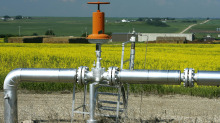Low natural gas price casts doubt on 'proven' reserves
 Most years, it’s an eye-glazing exercise. But calculating “reserves” – how much oil or gas an energy company has buried on its lands – has taken on a sudden new importance for an industry in the throes of a remarkable pricing spiral.
Most years, it’s an eye-glazing exercise. But calculating “reserves” – how much oil or gas an energy company has buried on its lands – has taken on a sudden new importance for an industry in the throes of a remarkable pricing spiral.Every spring, energy companies update their reserves based on price forecasts done at the end of the prior year. Price is an important consideration in determining the most important class of reserves, called “proven,” because a company can only say it’s capable of producing a certain volume of energy if it’s profitable enough to do so.
Normally, the year-end price estimates are a pretty good indication of what’s to come, and make for a reasonable estimate of a company’s reserves. But this year, a sudden drop in natural gas prices has raised significant question marks over the accuracy of the reserve figures that have been issued in recent weeks.
“It’s a safe assumption that a large part of Canada’s natural gas (NG-FT2.190.041.72%) reserves are [overstated],” said Eric Nuttall, portfolio manager for Sprott Energy Fund.
That has significant ramifications, especially for those looking to evaluate the worth of companies with major gas holdings. Reserves are an important component of calculating the net asset value of a company. And this year, they could be wrong, by a lot. The difference in assumptions is stark, and anyone looking at corporate reports might be led to expect stronger pricing than companies are actually getting. Indeed, gas prices have gotten bad enough that observers expect cash flow for some companies to dip into negative territory.
To illustrate the difference in expectations, take the price assumptions used by GLJ Petroleum Consultants, one of the most important reserve evaluators in the country. GLJ’s price “deck,” or forecast, for 2012 assumes second-quarter gas prices of $3.65 (U.S.) per million BTU, and a full-year average of $3.80.
The actual price of gas is far worse. Natural gas for delivery in the second quarter has traded at barely more than $2, while the average of futures prices for the remainder of 2012 is $2.53. That’s fully a third below the figure used to estimate reserves.
Some analysts are even more pessimistic. If gas stays at or below $2 for much of the year – a possibility, given the strong likelihood Canadian storage will fill up, and the chance U.S. storage will also near capacity, creating market havoc – this year’s reserve calculations could be substantially off the mark.
“Last year they were using $4.50 for the price deck. And we’ve seen over a 50-per-cent decrease in the price of gas,” said Marin Katusa, an analyst with Casey Research. “The real [reserve] writedowns are going to be up to 40 per cent.”
Don Rawson, managing director of institutional research at AltaCorp Capital Inc., is more cautious: he suggests perhaps 20 per cent of gas reserves wouldn’t be on the books if the math was done at today’s prices.
The likelihood that reserves are overstated is not evidence of wrongdoing. Companies have followed proper procedure in generating their numbers. But the markets have simply changed, and fast. And the speed of those changes should prompt caution, observers warn, especially since markets haven’t necessarily kept pace.
“I’ve been pretty animate in my views that most natural gas stocks are still quite overvalued right now, based upon where I think AECO [the price of gas in Alberta] is going in the next quarter or two,” Mr. Nuttall said. Alberta storage, he noted, is already over 80 per cent full – and companies haven’t even entered the summer season when storage additions typically begin.
The result could be prices low enough to force companies into a very uncomfortable situation later this year, selling off their best assets – including land containing oil – since less lucrative gas properties are unlikely to attract buyers. Already, several companies, including Fairborne Energy Ltd., have put themselves up for sale.
“I’m sure there will be some forced transactions,” Mr. Rawson said. “And it’s possible that in the short-term there are companies that could face negative cash flow, which is hard to stomach and hard to believe. But it’s possible.”
Mr. Nuttall, however, believes the full import of that likelihood has yet to sink into the markets.
“There’s a world of hurt coming … but guys aren’t afraid yet, which tells me we’re not even close to a bottom,” he said.
“When Tourmaline [Oil Corp., now at $22] is at $18, when Progress [Energy Resources Corp., now at $10] is $8, when Birchcliff [Energy Ltd., now $7.25] is $5, when Advantage [Oil & Gas Ltd., now at $3.35] is at $2.50, when Celtic [Exploration Ltd., now at $14.50] is at $12 – that’s when guys will be afraid.”
You can return to the main Market News page, or press the Back button on your browser.

